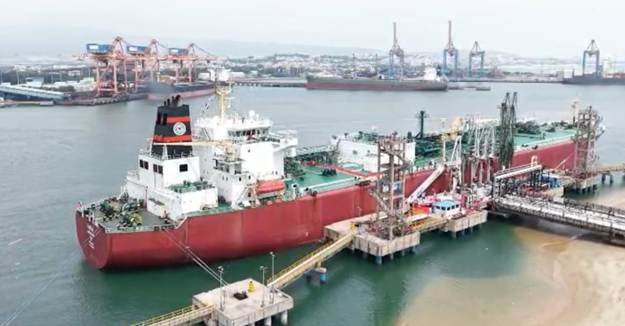India’s maritime sector in golden era, says Sonowal
Minister of Ports, Shipping and Waterways (MoPSW) Sarbananda Sonowal has received India’s third Very Large Gas Carrier (VLGC) “Shivalik” under the Indian flag, a milestone in India’s maritime resurgence and energy security.
Welcoming the vessel at Visakhapatnam Port 6 Oct, Sonowal said the induction of ‘Shivalik’ by the Shipping Corporation of India Ltd (SCI) reflects India’s growing capacity for “Atmanirbharata” (self-reliance) in the shipping sector and its increasing participation in the global energy trade http://commerce.gov.in.
“The arrival of Shivalik under our national flag is not just a fleet expansion, it is a statement of confidence in India’s maritime resurgence and our growing strength as a leading global maritime nation,” Sonowal said.

“This initiative reinforces India’s commitment to building a strong, self-reliant, and globally competitive shipping sector to set the economy sail towards Viksit Bharat.”
The 82,000 CBM VLGC Shivalik, named after the Himalayan range, was inducted into SCI’s fleet on 10 Sept 2025, and joins Sahyadri and Anandamayi as the corporation’s third VLGC. Built in South Korea, the 225-meter-long carrier represents cutting-edge maritime engineering with segregated tanks, advanced temperature control, and compliance with global safety and efficiency standards.
‘Shivalik’ completed her maiden voyage by loading more than 46,000 metric tonnes of liquefied petroleum gas (LPG) — comprising propane and butane — at Ruwais, UAE, before arriving in Visakhapatnam for discharge operations for Indian Oil Corporation Ltd (IOCL).
The Ministry said the vessel’s arrival under the Indian flag has “immense strategic significance” as it strengthens India’s energy connectivity with the Arabian Gulf and ensures secure, efficient, and reliable LPG transportation to the nation.
“Our seafarers are the ambassadors of India’s maritime might,” Sonowal said, addressing the 29-member crew led by Capt. Bhaskar Tandon. “The Shivalik stands as a beacon of our determination to expand Indian-flag tonnage and reduce dependence on foreign carriers for critical energy cargo.”
He added that India is moving strongly toward becoming one of the world’s top five maritime nations by 2047.
“We are in the midst of the golden era for India’s maritime sector,” Sonowal said. “From policy reform to infrastructure creation, the transformation we are witnessing today is unprecedented. India’s maritime renaissance is well underway.”
The Minister outlined how this milestone aligns with the government’s larger strategy for maritime expansion and energy resilience. SCI’s ongoing collaborations with Oil and Steel PSUs, under the guidance of the Ministries of Ports, Shipping & Waterways (MoPSW) and Petroleum & Natural Gas (MoPNG), are paving the way for a new era of Indian-owned and Indian-flagged vessels.
“SCI is currently working with Oil PSUs to aggregate demand for 112 vessels and form a joint venture (JV) for long-term fleet augmentation. The initiative is expected to contribute to the nation’s efforts to save US$75 billion (Rs.6 trillion) in foreign exchange paid annually towards freight charges to foreign shipping lines,” confirmed Sonowal.
Similarly, SCI’s partnership with Steel PSUs aims to strengthen the dry bulk segment, while its plan to establish the Bharat Container Shipping Line (BCSL) will boost India’s footprint in container shipping — enhancing EXIM efficiency and competitiveness.
“These initiatives not only reinforce India’s energy security and maritime capacity but also boost domestic shipbuilding, repair, and ancillary industries,” he added. “They will create high-quality employment and position India as a maritime power with resilience, innovation, and pride.”
The Minister highlighted a series of transformative policy measures undertaken by the government to build a robust maritime ecosystem. Sonowal said the Rs.69,725 crore comprehensive package for the maritime and shipbuilding sectors will accelerate shipbuilding, modernisation, and competitiveness.
The government has also extended the Shipbuilding Financial Assistance Scheme (SBFAS) till 2036 with a corpus of Rs.24,736 crore, ensuring sustained support for Indian shipyards.
In addition, a Maritime Development Fund (MDF) worth Rs.25,000 crore — comprising a Rs.20,000 crore investment fund and a Rs.5,000 crore interest incentivisation fund — has been established to enable long-term financing and strengthen the industry’s global competitiveness.
The Shipbuilding Development Scheme (SbDS), with an outlay of Rs.19,989 crore, aims to expand India’s domestic shipbuilding capacity to 4.5 million gross tonnage annually, boosting employment and skill development.
Sonowal said these measures, coupled with infrastructure status for large vessels, customs duty exemptions for shipbuilding components, and reforms such as the extension of the tonnage tax regime to inland vessels, are “laying the foundation of a globally competitive maritime ecosystem.
“Our vision is to make India a design–build–finance–own–repair–recycling powerhouse,”. A future where a far larger share of India’s EXIM cargo sails on Indian-built and Indian-owned vessels. We are fixing historic cost disadvantages, creating world-class clusters, and accelerating the green transition that will power Viksit Bharat 2047.”
The Minister concluded by urging all stakeholders to seize this moment of transformation.
“The arrival of Shivalik symbolises India’s march toward maritime self-reliance and strength. Together, we are scripting a new chapter in India’s maritime destiny — one that sails under the proud tricolour, with confidence, courage, and conviction.”
Equipped with segregated tanks and advanced temperature management systems, Shivalik represents cutting-edge maritime engineering and operational efficiency. Capt. Tyagi said SCI is working closely with oil public sector undertakings (PSUs) to expand Indian tonnage, reduce dependence on foreign carriers, and enhance operational reliability and cost efficiency.
SCI’s fleet currently comprises 58 owned vessels, totalling 5.26 million DWT, across segments including crude carriers, product tankers, bulk carriers, container vessels, LPG carriers, and offshore support vessels. Fiinews.com









